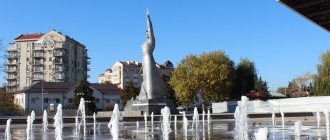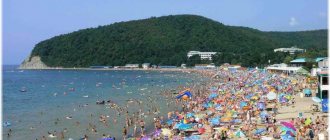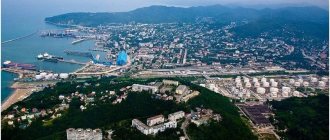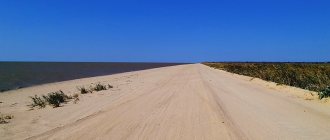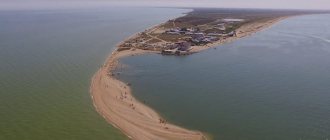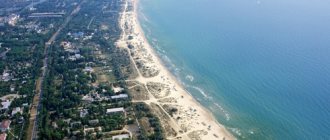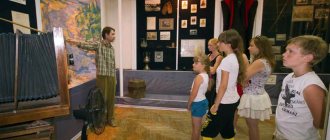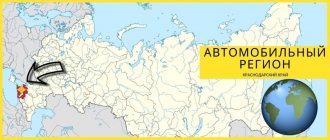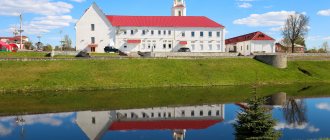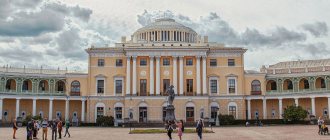For the twentieth anniversary of the victory in the Great Patriotic War, the capital of Kuban was decorated with a wonderful monumental complex. On Victory Square, opened next to Gorky Park, stood a five-meter tall figure of a Soviet soldier - the winner of German fascism. With his head held high, the famous PPSh machine gun in his hands, and a defeated fascist banner under his feet. This is how residents of thousands and thousands of cities and villages in Eastern Europe from the Volga to the Elbe remembered Soviet soldiers.
The inhabitants of Kuban will never forget the exploits of the liberating soldiers. The Hitler regime ruled our land for six months, staining itself with monstrous crimes for which there is no justification. The liberation of the capital of Kuban was not easy for the units of the Soviet Army. 1800 soldiers laid down their lives in the battles for Krasnodar. The monumental complex is dedicated to their memory.
On the sides of the central figure of the warrior-liberator, like bowed banners, there are two steles. The left depicts the moment of the fierce battle for Krasnodar, and the right depicts a cordial meeting between the city residents and their liberators.
The monument is cast from concrete with diorite filler, its entire surface is carefully minted. A container with historical information about the heroes and liberators of Krasnodar, as well as the names of its authors and builders, was laid in the foundation of the monument.
Four decades have passed since the opening of the complex, but it still attracts the attention of Krasnodar residents and city guests. Every year on the day of the Great Victory, hundreds of Kuban residents come to the monument to lay flowers and bow to the memory of Soviet soldiers.
Memorial complex Malaya Zemlya
Small Earth.
Monument to “Our Heroes” / photo from wikipedia.org Where is it located
Novorossiysk, Admiral Serebryakov embankment.
Why is this interesting?
A visit to this memorial complex is a tribute to the feat of Soviet soldiers during the Great Patriotic War.
The memorial was created on the site of the bridgehead, the defense of which lasted 225 days. Here in 1943 the operation to liberate the city began.
To defend this small piece of land, 70 thousand Soviet soldiers were sent here. The exact number of deaths is still unknown.
The central object of the complex is a memorial in the shape of the bow of a ship.
Its halves meet at a height of 22 m above the ground. There is a museum inside.
An alley of 225 poplars leads to the memorial, one for each day of defense.
On the ground around the memorial there are traces of trenches and trenches.
Despite the large number of visitors, it is always quiet and peaceful here. On the other side of the bay you can see the city. The panorama of the city looks especially attractive after sunset, when the lights come on.
How to get there
The memorial and other historical attractions of the Krasnodar Territory can be reached by public transport, the nearest stop is “Malaya Zemlya”. It is reached by buses No. 1 and 41m, trolleybus No. 7, minibuses No. 7, 10, 21, 22, 27, 28, 31, 38.
Abrau
Symbol of the beginning of the Caucasus Range (Main Caucasus). Because the named ridge starts on the peninsula of the same name (everything that was to the north-west is, in fact, just hills). But you will find the largest freshwater reservoir in the Krasnodar region closer to the sea, already at an altitude of only 84 meters, in the eastern half of the peninsula. Territory of the municipality of Novorossiysk. The size of the water mirror is 2,930 by 940. And the maximum depth is 10 m.
Russian Gate - a monument of Ottoman architecture
Russian Gate in Anapa
Where is it located?
In the southern part of Anapa, on the territory of the 30th Anniversary of Victory Park.
Why is this interesting?
These gates became Russian only in 1828, when Anapa was liberated from the Ottoman yoke.
This is all that remains of the fortress, built in 1783. The fortress was the main stronghold of the Ottoman Empire in the North Caucasus. The slave market operated here, and military operations to capture cities were controlled from here.
Russian troops sought to destroy the fortress, but it was not easy to break through the numerous fortifications. In 1791, Anapa fell, which forced the Turkish side to conclude a peace treaty. Under the terms of this treaty, Crimea was ceded to Russia, and Anapa remained part of the Ottoman Empire.
With their aggressive foreign policy, the Turks repeatedly violated the terms of the treaty. This led to Russia declaring war on the Ottoman Empire in 1827. In 1828, the Russian army took the fortress and the city. Since 1829, Anapa became part of Russia.
On the territory of the Russian Gate there are many monuments dedicated to the events of those years. The fortress gates themselves received the status of a monument of Ottoman military architecture.
How to get there
The path through the territory of the 30th Anniversary of Victory Park to the Russian Gate passes through the embankment. You can get to the park by minibuses No. 2, 7, 25.
Vorontsov Cave
We are talking about the leading karst attraction of the region - the Vorontsov cave system with a total length of 11,720 meters. Named in honor of the Russian count, whose estates were throughout the current Southern Federal District, as well as the Crimean Federal District. All entrances to the cavity are located in the fur valley of the upper Khosta and upper Kudepsta (Khosta district of Sochi) at different levels - up to 720 m.a.s.l. m. Vacationers observe bizarre stalactites and stalagmites. Late Paleolithic sites have been discovered in Vorontsovskaya.
Holy Trinity Cathedral - the oldest temple in Krasnodar
Inside the Holy Trinity Cathedral / photo from the official website
Where is it located?
Krasnodar, central microdistrict.
Why is this interesting?
This is the oldest cathedral in the city.
The first thing a tourist will appreciate is the uniqueness of the architecture. Red brick walls with exquisite patterns, green domes and tower tops make the temple unlike other cathedrals.
The first house of worship was opened here in 1902.
The ceremonial consecration of the entire temple took place in 1910. In 1934, the temple was closed due to religious repression. During the Great Patriotic War, the Germans opened the temple, but at the end of the war it was closed again. The Soviet government took away all the relics from the clergy: icons, jewelry, even furniture and candelabra.
In those years, many icons were destroyed, frescoes on the walls and stained glass windows were also damaged. The return of the building to the status of a church is the merit of local residents. They achieved this in 1990. Unfortunately, part of the spiritual heritage has been irretrievably lost, but at the moment the cathedral has been restored to its former majesty.
How to get there
The cathedral is located in the city center, near the Kuban embankment.
The nearest stops are “st. Gogol" along Kuban embankment and Oktyabrskaya, "st. Gorky" after Oktyabrskaya, "Oktyabrskaya" after Gorky, "Pashkovskaya" after Kirov. These stops can be reached by any transport that runs through the central microdistrict of Krasnodar.
Sculpture "Aurora"
At the highest point of the city of Krasnodar stands the majestic building of the best Kuban cinema, and next to it is the personification of the goddess of the dawn, the statue of “Aurora”. This architectural composition closes Krasnaya Street, being its best decoration. True, before us is not an ancient goddess from Ancient Greece, but a Soviet Komsomol member - in an overcoat, with a rifle over her shoulders, holding a star in her raised hand - a symbol of faith in the bright future of our country.
“Aurora” now stands on the spot where there once was a mound with a Cossack guard post. During Soviet times, archaeological excavations were carried out here, but the mound turned out to be empty.
Work on the monument and construction of the cinema began during the preparation for the 50th anniversary of Soviet power. The best masters of Kuban, Honored Sculptor of the RSFSR I.P., were chosen as the authors of the monument. Shmagun and artist-architect E.G. Lashuk, and the author of the project for the entire complex was the architect of the Sochi branch of the Yuzhgiprokomunstroy Institute E.V. Serdyukov. Moreover, all the work on creating the monument was carried out by Shmagun and Lashuk for free and their work was donated to the city.
The grand opening of the complex took place on May 7, 1967. In front of a huge crowd of Krasnodar residents and guests of the city, the leaders of Kuban cut the ribbon, the light blanket fell from the sculpture, and the majestic and inimitable sculpture of “Aurora” appeared before those gathered, which in recent years has become a real symbol of the Kuban capital.
The total height of the sculpture, made of forged aluminum, is 14 meters, and together with the pedestal, the total height of the monument is 16.8 meters. Unfortunately, the inscription engraved on the pedestal has not been preserved: “Power to the Soviets, peace to the peoples.”
Lermontov House-Museum in Taman
Exposition of the Lermontov House Museum in Taman / photo from the museum website
Where is it located
In Taman, near the bus station.
Why is this interesting?
Mikhail Lermontov stayed here in 1937 on his way to military service.
Lermontov himself spoke unflatteringly about this city and called Taman “the worst little town of all seaside cities” (quote from “A Hero of Our Time”).
The poet’s mood is understandable; the upcoming service was actually an exile. He displeased the tsar with his poem “On the Death of a Poet,” which he dedicated to Pushkin. Later, Lermontov would make Taman one of the settings for A Hero of Our Time. The main character Pechorin also ends up in these regions with exile.
The museum opened in 1976. At first there were few exhibits: 30 paintings and an old Cossack chicken coop.
Now the museum has a large exhibition. There are manuscripts and drawings by Lermontov. In one house, household items used by the poet are preserved: from furniture and dishes to towels and icons.
How to get there
The nearest stop is the Archaeological Museum. You can get there by minibus No. 453.
Read about the natural attractions of the Krasnodar region here.
Khan Lake
The conversation is about the lake “zest” of the Yeisk region (which occupies the very northwestern end of the Kuban). The picturesque closed reservoir is located between the isthmus of Yasensky Bay, the Beysugsky Estuary and the mouth of the Yasen River (the entire “wet” settlement was named after it). The length of the water surface is 28 (including floodplains), and the greatest width is 7.7 km. Throughout the entire period, Khanskoye is surrounded by reeds, small floodplain bushes, and agricultural areas. And also tourist centers, for the sake of which guests of the Krasnodar region end up here. They are located on a small part of the perimeter facing the estuary (there are beaches consisting of a mixture of sand and shell rock).
Dolmens of the Krasnodar region
Dolmens are the most mystical historical attractions of the Krasnodar region.
Dolmens of the Krasnodar region are known throughout the world. In total there are about 2.5 thousand dolmens.
Not all dolmens are well preserved; from some only piles of stones remain. These are the most ancient historical sights of the Krasnodar region.
Below I will list the largest surviving dolmens.
Dzhubga dolmen - the most accessible
Where is
The village of Dzhubga, Tuapse district.
Why is this interesting?
This dolmen appeared in the 3rd century AD. e.
The size of the structure is 2.5 m x 1.5 m x 2 m. There is a round window in the stone.
According to one version, the dolmen served as a place for the funeral ceremony of the ancient Circassians.
How to get there
It’s easy to find the dolmen; it’s only 500 meters from the bus station.
You can only get to Dzhubga by car. There is no railway here. The dolmen is located on Kooperativnaya street. This is the territory of a former sanatorium not far from the Dzhubga tourist center.
Volkonsky dolmen is the only monolithic one
Where is
Not far from the village of Volkonka, Lazarevsky district.
Why is this interesting?
According to some reports, this is the only surviving monolithic dolmen in the world.
Such structures are called megaliths . This is a solid piece of sandstone, in which a cavity, a hole in the wall and a ladder to this hole are hollowed out.
The height of the dolmen reaches 4 m, with a flat platform on top. According to researchers, it is about 9.5 thousand years old.
Dolmens are considered acoustic structures. Volkonsky confirms this theory.
According to one version, wind enters the cavity through a round window. This produces sounds of different tones. The Volkonsky dolmen really hums, you can hear it. In addition, it is located in a seismically active zone, which makes sound waves resonate more strongly.
Next to the large dolmen there is another, smaller one.
One of the local legends says that these dolmens are brothers.
The legend is this: a young man from a noble family fell in love with a poor girl. His brother ordered him to forget about his beloved. But the young man decided that he would rather become a stone than live without his beloved. And immediately after these words it turned into a dolmen. His brother could not bear the bitterness of loss and also turned to stone. The girl turned into a stream, the water in which is cold at any time of the year.
How to get there
You can get to the Volkonsky dolmen by train.
You need to get off at the Volkonskaya station and walk up the main road of the village. The journey will take about 20 minutes.
If you go by car, then after leaving Lazarevskaya towards Sochi you need to not miss the sign “Volkonsky Dolmen”. There is a parking lot right behind it where you can leave your car. The journey on foot following the signs will take a few minutes.
Psekup dolmens are the most mysterious
Where is
Not far from the villages of Fanagoriyskaya, Bezymyanoye, Pyatigorskoye, Saratovskaya, Goryachiy Klyuch district.
Why is this interesting?
Psekupsky dolmens are as many as 20 buildings. Unfortunately, many of them are destroyed.
It is known that they appeared in the III-II centuries. BC. All dolmens are very massive. The approximate weight of each slab is 40 tons.
When you see these structures, the question arises: how could they be built without special equipment? But many of them are located in the mountains at a decent altitude.
How to get there
How to get to the Psekup dolmens is a difficult question. They seem to be specially hidden from people.
These are the most inaccessible dolmens in the region.
Sometimes they are found by accident.
There is a belief that dolmens hide from people, not allowing them to approach them.
In fact, travelers often track their route on a map and realize that they were several tens of meters from the dolmen, but did not see it.
The following coordinates are known:
- 44°30'58.84″N 39° 6'56.44″E - village of Fanagoriyskoe. The trough-shaped dolmen is located in the Gavril Kirasi clearing near the northern part of the village. The structure was given the number 1544. Previously, it was hollow, but is now covered with earth. Local residents looked for treasures in it and tried to save the dolmen from destruction after excavations;
- 44°24'27.40″N 39° 7'23.47″E - Afanasyevsky Postik farmstead in the village of Bezymyanny. Dilapidated large dolmen near the Sobachka river, number 1545;
- 44°36'27.40″N 38°58'25.96″E - west of the village of Pyatigorskoye. You need to go up the Pyatigorka (Tkhamashinka) river. Number 1546;
- 44°42'13.75″N 39°13'7.72″E - Saratovskaya village, left bank of the Psekups River, an under-mound dolmen excavated in the 30s of the last century. Assigned number 1547. The dolmen is partially destroyed. It was assumed that there was no hole in it, which is found in similar structures.
Sometimes inaccessibility is more of a plus than a minus. There are rarely people near these dolmens. There is no garbage or ribbons on trees that tourists tie as souvenirs. They say that only in such places dolmens retained their true energy.
Agur waterfalls
This is the “business card” of the mid-mountain part of the Khostinsky urban district of Sochi (a resort stretching along the sea for as much as 145 km). The name itself says that you need to climb to the tract along the Agura. Up the gorge formed by this stream. To the east is the Big Akhun observation tower. And to the west is a huge monument dedicated to the Greek Prometheus (myths claim that it was here that Hephaestus chained him to a rock on the orders of Zeus, and an eagle pecked at his liver - that’s why the rocks there are Eagle). Now to Agura itself. This refers to the cascade in its upper reaches. There are 3 noticeable steps. The highest is 30 m (the next attraction after the Devil’s Font).
Stone Sea
In Kuban there is not only the Black Sea, but also the “stone” sea. Latitude: 44.017632 Longitude: 39.989548. On the border with the Republic of Adygea, this is the point for your first visit. The ridge christened with this nickname is like a bridge between Azish-Tau and Oshten. The highest elevation of the chaotic limestone massif is 1,750 meters. The most interesting corner is the zone of deep craters and Lake Cave. As a rule, one gets here by road starting from the ecological resort of Dakhovskaya (Maikop district, Adygea). The road ends at the point of the Lago-Naki plateau, from where a trail leads higher.
As a conclusion, it remains to add that of all the regions of the Fatherland, it is in the northwestern Caucasus that there are the most dolmens - the mysterious megaliths of antiquity. What is this? Graves? "Portal"? Maybe some kind of temples in honor of the natural forces that created all the beauty described above?
